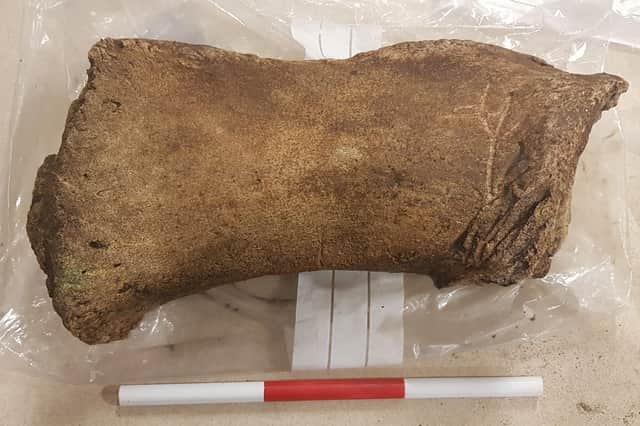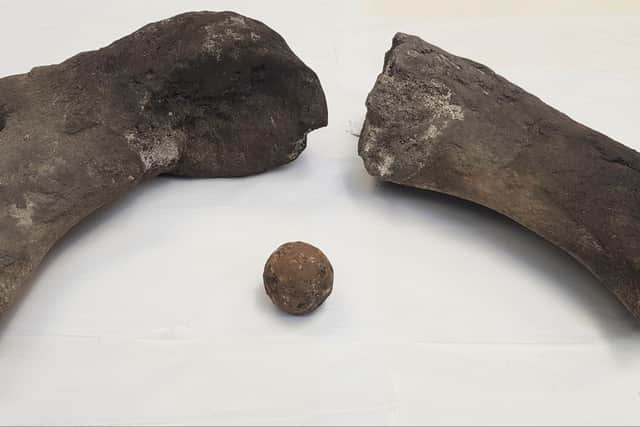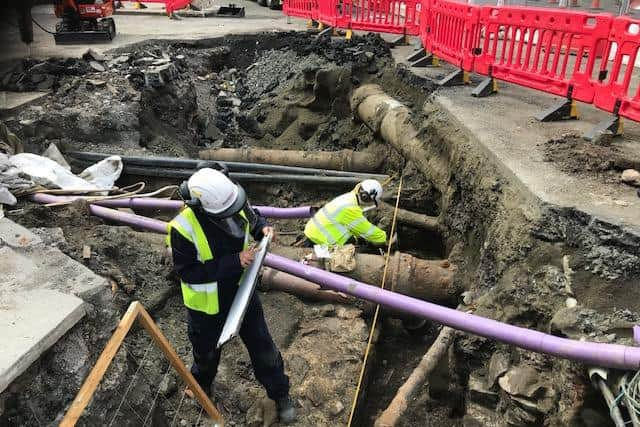Whale remains found buried beneath Edinburgh tramworks site in Leith


Two large bones from the fin of a large male sperm whale were found buried beneath the ground between a post office and a scrap yard on Constitution Street in Leith.
It is thought they may have been brought back to Leith as a memento or “trophy” from one of the many whaling expeditions which left the port bound for Arctic and Atlantic waters between 1616 and
1963.


Advertisement
Hide AdAdvertisement
Hide AdHowever, it is believed they could be from a whale as much as 800 years old. Carbon dating tests are to be carried out to determine whether the bones may date back to the medieval era, when Leith’s first settlements date from.
The bones, which were identified by experts at the National Museum of Scotland, were found during a four-month dig along stretches of Constitution Street, which had to be brought to a halt along with all the tramworks on the route, at the end of March, due to the coronavirus pandemic.
Investigations are resuming this month, to coincide with the restart of the tramworks.
Other key discoveries included remains of a large stone wall, found beneath the junction of Bernard Street and Constitution Street, where a statue of Robert Burns has been temporarily removed to accommodate the tramworks.


Advertisement
Hide AdAdvertisement
Hide AdIt may have been part of a previously unknown seawall built as part of the fortification of Leith in the 16th and 17th centuries.
A small iron cannonball recovered from the route of the tram is believed to date from the 17th century, when Leith was under the control of Oliver Cromwell’s forces.
John Lawson, Edinburgh council’s archaeologist, said: “The discovery of the whale bones was really unusual and expected. It’s a real mystery how they have ended up there.
“Leith was really important for its whaling industry from the early 17th century to the 20th century, but it would have been happening in the North Sea and North Atlantic as far back as medieval times.
Advertisement
Hide AdAdvertisement
Hide Ad“Another question is whether they could have been brought to Leith as some kind of memento or trophy, but they’re from the fin, which would be a very strange part of a whale to keep.
“They’re very heavy, they’re almost like picking up a stone. They’re a very odd thing to find in an archaeological dig. I’ve not come across anything like this before.
“They could have been brought for some reasons back from the Atlantic to Leith or could be from a whale that just beached on the shore, has been cut up and then had its bones dumped.
“It will be really interesting to date the bones, which may tell us something about the 20th century whaling industry or whaling as far back as 800 years ago.
Advertisement
Hide AdAdvertisement
Hide AdBob Will, senior project manager at Guard Archaeology, which is working on the tram route, said: “The project is allowing us to discover more about the history and development of Leith, from the medieval period to the modern day.”
A message from the Editor:
Thank you for reading this story on our website. While I have your attention, I also have an important request to make of you.
With the coronavirus lockdown having a major impact on many of our advertisers - and consequently the revenue we receive - we are more reliant than ever on you taking out a digital subscription.
Subscribe to scotsman.com and enjoy unlimited access to Scottish news and information online and on our app. With a digital subscription, you can read more than 5 articles, see fewer ads, enjoy faster load times, and get access to exclusive newsletters and content.
Visit www.scotsman.com/subscriptions now to sign up.
Advertisement
Hide AdAdvertisement
Hide AdOur journalism costs money and we rely on advertising, print and digital revenues to help to support them. By supporting us, we are able to support you in providing trusted, fact-checked content for this website.
Joy Yates
Editorial Director
Comment Guidelines
National World encourages reader discussion on our stories. User feedback, insights and back-and-forth exchanges add a rich layer of context to reporting. Please review our Community Guidelines before commenting.